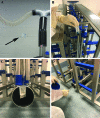Staphylococcus xylosus PCR-validated Decontamination of Murine Individually Ventilated Cage Racks and Air Handling Units by Using 'Active-Closed' Exposure to Vaporized Hydrogen Peroxide
- PMID: 29256369
- PMCID: PMC5710153
Staphylococcus xylosus PCR-validated Decontamination of Murine Individually Ventilated Cage Racks and Air Handling Units by Using 'Active-Closed' Exposure to Vaporized Hydrogen Peroxide
Abstract
Vaporized hydrogen peroxide (VHP) is used to decontaminate clinical, biocontainment, and research animal rooms and equipment. To assist with its implementation in a murine facility, we developed a safe and effective method of VHP sterilization of IVC racks and air handling units (AHU). Safety of VHP decontamination was assessed by ensuring VHP levels dissipated to less than 1 ppm in the room prior to personnel reentry and inside the primary enclosure prior to the return of mice; this condition occurred at least 18 h after the VHP cycle. Efficacy of VHP sterilization was assessed by using chemical indicators, biologic indicators, and PCR testing for Staphylococcus xylosus, a commensal organism of murine skin and an opportunistic pathogen, which was present in 160 of 172 (93%) of specimens from occupied IVC racks and the interior surfaces of in-use AHU. Neither mechanized washing nor hand-sanitizing eradicated S. xylosus from equipment airway interiors, with 17% to 24% of specimens remaining PCR-positive for S. xylosus. 'Static-open' VHP exposure of sanitized equipment did not ensure its sterilization. In contrast, 'active-closed' VHP exposure, in which IVC racks were assembled, sealed, and connected to AHU set to the VHP cycle, increased the proportion of chemical indicators that detected sterilizing levels of VHP inside the assembled equipment, and significantly decreased PCR-detectable S. xylosus inside the equipment. Supplementing bulk steam sterilization of the primary enclosure with VHP sterilization of the secondary housing equipment during room change-outs may help to mitigate opportunistic agents that jeopardize studies involving immunodeficient strains.
Figures







Similar articles
-
Facility-wide Eradication of Corynebacterium bovis by using PCR-validated Vaporized Hydrogen Peroxide.J Am Assoc Lab Anim Sci. 2018 Sep 1;57(5):465-476. doi: 10.30802/AALAS-JAALAS-17-000135. Epub 2018 Jul 13. J Am Assoc Lab Anim Sci. 2018. PMID: 30005716 Free PMC article.
-
PCR Prevalence of Murine Opportunistic Microbes and their Mitigation by Using Vaporized Hydrogen Peroxide.J Am Assoc Lab Anim Sci. 2019 Mar 1;58(2):208-215. doi: 10.30802/AALAS-JAALAS-18-000112. Epub 2019 Feb 22. J Am Assoc Lab Anim Sci. 2019. PMID: 30795821 Free PMC article.
-
Biodecontamination of animal rooms and heat-sensitive equipment with vaporized hydrogen peroxide.Contemp Top Lab Anim Sci. 2001 Nov;40(6):18-21. Contemp Top Lab Anim Sci. 2001. PMID: 11703051
-
Non-Manual Techniques for Room Disinfection in Healthcare Facilities: A Review of Clinical Effectiveness and Guidelines [Internet].Ottawa (ON): Canadian Agency for Drugs and Technologies in Health; 2014 Apr 30. Ottawa (ON): Canadian Agency for Drugs and Technologies in Health; 2014 Apr 30. PMID: 25577931 Free Books & Documents. Review.
-
Inactivation of animal and human prions by hydrogen peroxide gas plasma sterilization.Infect Control Hosp Epidemiol. 2009 Aug;30(8):769-77. doi: 10.1086/598342. Infect Control Hosp Epidemiol. 2009. PMID: 19563265 Review.
Cited by
-
Vaporized Hydrogen Peroxide Decontamination of N95 Respirators in a Dedicated Animal Research Facility for Reuse During a Novel Coronavirus Pandemic.Appl Biosaf. 2020 Sep 1;25(3):142-149. doi: 10.1177/1535676020936381. Epub 2020 Sep 1. Appl Biosaf. 2020. PMID: 38602982 Free PMC article.
-
Facility-wide Eradication of Corynebacterium bovis by using PCR-validated Vaporized Hydrogen Peroxide.J Am Assoc Lab Anim Sci. 2018 Sep 1;57(5):465-476. doi: 10.30802/AALAS-JAALAS-17-000135. Epub 2018 Jul 13. J Am Assoc Lab Anim Sci. 2018. PMID: 30005716 Free PMC article.
-
Effects of Corynebacterium bovis on Engraftment of Patient-derived Chronic-Myelomonocytic Leukemia Cells in NSGS Mice.Comp Med. 2019 Aug 1;69(4):276-282. doi: 10.30802/AALAS-CM-18-000138. Epub 2019 Jul 26. Comp Med. 2019. PMID: 31349880 Free PMC article.
-
PCR Prevalence of Murine Opportunistic Microbes and their Mitigation by Using Vaporized Hydrogen Peroxide.J Am Assoc Lab Anim Sci. 2019 Mar 1;58(2):208-215. doi: 10.30802/AALAS-JAALAS-18-000112. Epub 2019 Feb 22. J Am Assoc Lab Anim Sci. 2019. PMID: 30795821 Free PMC article.
-
Low-cost, Small-scale Decontamination of Laboratory Equipment by Using Chlorine Dioxide Gas.J Am Assoc Lab Anim Sci. 2019 Sep 1;58(5):569-576. doi: 10.30802/AALAS-JAALAS-18-000105. Epub 2019 Aug 29. J Am Assoc Lab Anim Sci. 2019. PMID: 31466553 Free PMC article.
References
-
- Bier ME. 1987. Method of vaporizing multicomponent liquids. US Patent no. RE.4642165 [Cited 15 June 2017]. Available at: http://patft.uspto.gov/netacgi/nph-Parser?Sect1=PTO1&Sect2=HITOFF&d=PALL...
-
- Bradfield JF, Wagner JE, Boivin GP, Steffen EK, Russell RJ. 1993. Epizootic fatal dermatitis in athymic nude mice due to Staphylococcus xylosus. Lab Anim Sci 43:111–113. - PubMed
MeSH terms
Substances
LinkOut - more resources
Full Text Sources
